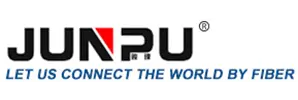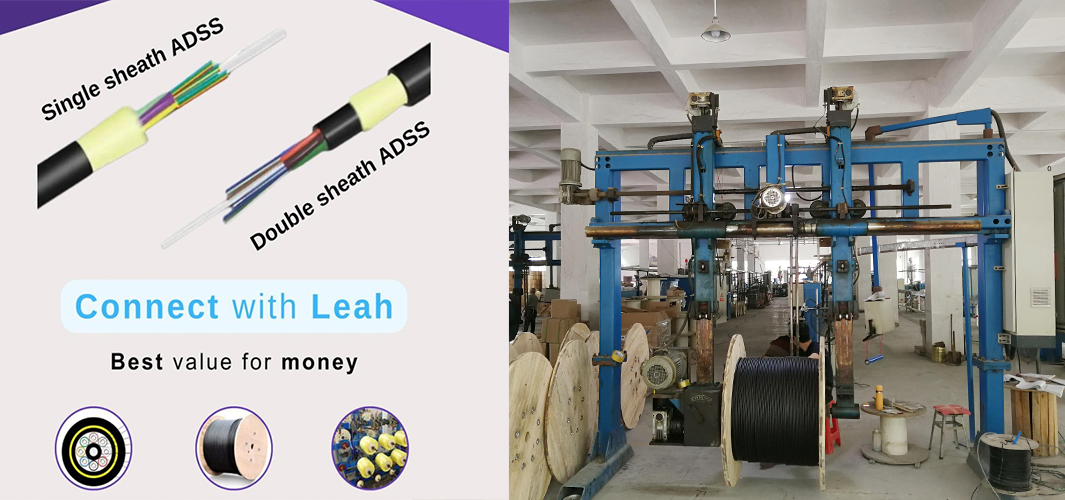
-
Home
-
Products
- Solution
- WHY JUNPU
- Services
- Resources
- News
- Contact Us

ADSS cable is loose tube stranded. Fibers, 250μm , are positioned into a loose tube made of high modulus plastics. The tubes are filled with a water-resistant filling compound. The tubes (and fillers) are stranded around a FRP (Fiber Reinforced Plastic) as a non-metallic central strength member into a compact and circular cable core. After the cable core is filled with filling compound. it is covered with thin PE (polyethylene) inner sheath. After stranded layer of aramid yarns are applied over the inner sheath as strength member, the cable is completed with PE or AT (anti-tracking) outer sheath.

Self-Supporting Design:
One of the most distinctive features of ADSS fiber optic cable is its self-supporting design. Unlike traditional fiber optic cables that require additional support structures like messenger wires or overhead attachments, ADSS cables are designed to support their weight along the span without any additional support. This feature simplifies installation, reduces costs, and minimizes the environmental impact of installation.
Dielectric Material:
ADSS cables are made using dielectric materials, which means they do not contain any metallic components. This dielectric nature makes them immune to electrical interference and provides excellent insulation properties. As a result, ADSS cables are suitable for deployment in high-voltage electrical environments, such as power utility corridors.
Lightweight and Compact:
ADSS cables are lightweight and compact, making them easy to handle during installation. Their compact size is advantageous in crowded utility pole and duct environments, where space is limited. This feature also reduces the load on support structures, further simplifying installation.
Long-Span Capabilities:
ADSS cables are designed for long-span installations, often spanning several kilometers between support structures. This makes them ideal for applications in rural and remote areas, as well as for connecting buildings or facilities over large distances without the need for additional support infrastructure.
ADSS Fiber Optic Cable is special due to its self-supporting design, dielectric properties, lightweight nature, and long-span capabilities. These characteristics make it particularly well-suited for specific applications, such as telecommunications in challenging environments and power utility communications where electrical interference is a concern.
Maintaining ADSS (All-Dielectric Self-Supporting) Fiber Optic Cables is crucial to ensure their long lifespan and reliable performance in various environments. Here are four key maintenance practices:
Regular Visual Inspections:
Conduct regular visual inspections of the ADSS cable route and support structures. Look for any signs of damage, wear, or sagging. Check for loose or damaged hardware on support poles or towers.
Inspect the cable itself for physical damage, such as cuts, abrasions, or cracks in the outer sheath. Any visible damage should be addressed promptly.
Environmental Monitoring:
Keep an eye on the environmental conditions in the cable's vicinity. Extreme weather conditions, temperature fluctuations, and exposure to UV radiation can affect the cable's performance.
Monitor for signs of tree growth or vegetation that might encroach on the cable's path, as this can lead to physical damage.
Regular Tension Checks:
ADSS cables need to maintain proper tension to avoid excessive sagging, which can impact performance and safety. Periodically check the cable's tension using appropriate tension monitoring equipment.
If the cable tension is outside acceptable limits, take corrective actions, which may include tension adjustments or re-supporting the cable.
Preventive Maintenance and Repairs:
Implement a preventive maintenance program that includes periodic inspections, cleaning, and minor repairs as needed. Address any identified issues promptly to prevent further deterioration.
In case of severe damage or cable failure, consult with qualified technicians or professionals to assess the extent of the damage and plan for necessary repairs or replacements.
 Call us on:
Call us on:  Email Us:
Email Us:  Wanhua Science and Technology Park, No. 528, Shunfeng Road, Donghu Street, Linping District, Hangzhou City, Zhejiang Province
Wanhua Science and Technology Park, No. 528, Shunfeng Road, Donghu Street, Linping District, Hangzhou City, Zhejiang Province